Siena: The Contrade and The Palio
History
The Contrade (Districts) of Siena were instituted between the end of the 12th and the beginning of the 13th century, with administrative (tax collection, road maintenance) and public safety (police) responsibilities, etc..
These institutions, quartered in or around the parish churches, public meeting places or places of worship, were governed by a kind of mayor, who was answerable directly to the Podestà (Chief of Justice) and was assisted by councillors elected by the people of Contrada.
The Structure of the contrade was completed after the formation of Military Companies (the army of the Republic) which enrolled every able man from 18 to 70 years of age. The Military Companies were in turn grouped into the so-called “Terzi” (Thirds), corresponding to the three territories Siena had been divided into : the Terzo di Città (a white cross on red ground), the Terzo di San Martino (St. Martin and the beggar on a wine-red ground), and the Terzo di Camollia (a black K on white ground).
Each Terzo was commanded by a Master Standard-bearer (Gonfaloniere Maestro). The Captain of the People bore a standard with a Crowned Lion Rampant on red ground: he was the supreme Commander of the Militia.
In the 14th century, the “famiglie” (clans) of Siena were distributed among the 42 Contrade, which were reduced to 23 between the 15th and 16th centuries.
In time, the political and administrative reasons that had brought about the creation of the Contrade, became obsolete and the latter turned their attention more and more to the organisation of public games that had long been current in the town.
The 23 Contrade took the names of Aquila (Eagle), Bruco (Caterpillar), Chiocciola (Snail), Civetta (Owl), Drago (Dragon), Gallo (Cockerel), Giraffa (Giraffe), Istrice (Porcupine), Leone (Lion), Liocorno o Leocorno (Unicorn), Liofante or Torre (Elephant or Tower), Lupa (She-wolf), Montone (Ram), Nicchio (Shell), Oca (Goose), Onda (Wave), Orso (Bear), Pantera (Panther), Quercia (Oak), Selvalta or Selva (High Forest or Forest), Spadaforte (Strong Sword), Tartuca (Tortoise), Vipera (Viper).
No documents exist explaining why the names (that were probably prompted by popular imagination or fancy or by some special event) were actually chosen.
1675 seems to be when six of these Contrade were suppressed, to wit: Gallo, Leone, Orso, Quercia, Spadaforte and Vipera.
The Contrade today
Each contradaiolo (contrada member) pays an annual contribution, called “protettorato” (protectorate). The organisation of the Contrade, as we have already mentioned, is mediated by various organisms created to cope with the various activities the Contrada decides to embark on.
One of the most important sectors is the Young Members’ activities, as the sons and daughters of the Contrada represent its “future”. The young are schooled in the history of their own and of the other Contrade.
The Women’s Group is also entrusted with the preparation of the Children’s Festal banquets (one of the most important being annual feast celebrating the Birth of the Virgin on the 8th September, when the children of each Contrada deck-out their Contrada’s shrine dedicated to the Virgin; in the evening, all the children sit down to a banquet laid out along the street)
The most important festival is the feast-day of the Patron Saint of the Contrada (which is celebrated by nearly all the Contrade on the nearest Sunday to the Saint’s day proper): the streets of the Contrada – are lit by the “braccialetti” (bracelets) – kind of wall-torches in carved wood, painted in the colours of the Contrada – with bunches of light bulbs or little tallow lamps with great floating wicks that burn through most of the night.
On the eve of the Feast-day, the Priore (Prior) of the Contrada, accompanied by the Seggio (governing body) and by the Popolo (People of the Contrada), receives the representatives of the allied contrade at the frontier of the Contrada. Preceded by a drum and by the standard-bearers, the procession goes to the Contrada’s Oratory to sing Vespers.
Afterwards, everyone pours out into the streets, where games are played, such as the “Children’s Palio”, the Sack Race and Climbing the May Pole and many others, invented by the Contrade.
Above all, everybody sings a tune, which is common to all seventeen contrade, when “speaking of Siena”, which is fitted to extemporary verses, praising one’s own Contrada or denigrating its enemies.
Then one drinks wine. Festivities go on until late at night. In the morning, mass is sung in the Oratory and the costumed Comparsa, consisting of dozens of drummers, standard-bearers, etc…, leads the procession round the town, to pay tribute to the “protectors” (This tour is repeated on the following Sunday, only this time the procession walks around the outsode of the medieval town walls, following the so-called “giro di campagna” (country walk).
Towards the late afternoon, the whole procession (Comparsa, Priore, Seggio and Popolo) triumphantly return to their own Contrada.
The Società di Contrada
The first Società di Contrada came into being in the 19th century and are in charge of the Contrada’s yearly activities. They are generally based in rooms adjacent to the Contrada headquarters and generally include a communal room, where meetings, dances and various other events are staged; recreation rooms, a bar and a well-equipped kitchen.
The activities they organise are many: cultural, sporty, social (e.g.: blood-donor-groups). The bar and the recreation rooms are looked-after by the members of the contrada, who take it in turns (without any regard as to class or social standing and entirely voluntarily) to serve at the bar and the tables.

The kitchen is mostly entrusted to the Women’s Group, who use it for the banquets, specially the banquet on the eve of the Palio, if the Contrada is running, which is called the Cena della Prova Generale (Banquet of the General Rehearsal) when up to over a thousand people have to be fed.
The Carriera (Race) in the Piazza del Campo today – The “Drawing” of the Contrade
Drawing the Contrade by lots is the first act of the Palio, and is performed about a month before the race (the last Sunday of May for the July Palio and the Sunday after the July Palio for the August one). 10 Contrade take part in the race. The rules which govern the drawing by lots are in fact less complex than one might think.
The seven Contrade which haven’t run in the preceding July Palio are entitled to run in the July Palio of the following year. The remaining three places are assigned according to the luck of the draw, to three of the Contrade who did take part, bringing the number of the participants up to the statutory ten.
The same method is adopted for the August Palio, wherefore the two Carriere (races) of July and August are totally unrelated to each other as regards the Contrade participating in them. A Contrada, for instance, might run twice in the same year, but would automatically be excluded from the two “carriere” in the following year, unless it were to be again drawn by lot.
On the morning of the “Sorteggio” (drawing), the standards of the seven Contrade running in the next Palio by right are hung outside the first floor windows of the Palazzo Pubblico.
The Piazza del Campo is prepared
For a Sienese, “Terra in Piazza” (earth on the Piazza del Campo) means Palio: joy, hope and rivalry. Shouts, invocations, throbbing songs surge from street to street, from square to square, up to the final explosion (this time, only in the winning Contrada) after the race.
These are the moments of greatest inner delight to a Sienese, and can only be compared to the moment in which the Palio in handed down to the winning Contrada in the “Piazza” and to the other moment of totally pagan exultation that assails the People of the victorious Contrada when they tumble into Santa Maria di Provenzano or into the Cathedral to offer thanksgiving for their victory.
Several days before the race, the road around the “Piazza” is covered with a thick layer of tufaceous earth, which will enable the hoofs of the horses to “bite” the ground better. the stands for the spectators, the “Judges” stans, where the Captains and Lieutenants of the Contrade also have their seats, as well as the stand of the Priori are all set up against the buildings all around the square.
The Judges’ near the Costarella dei Barbieri (the horses’ starting and arrival post), the Priori’s near the Chiasso Largo. The shell-shaped centre of the square, capable of holding some 40.000 spectators, is surrounded with metal barriers. At the Costarella dei Barbieri, a contraption is set up, called the “verrocchio”, which is the piece of equipment used by the “mossiere” (starter), who is the only person allowed to start the horse off: the “verrocchio” causes a thick rope (canapo) stretched across the track, to drop suddenly once it has been drawn tight by a winch situated behind the barriers.
A few meters behind this rope, a second, thinner and shorter one is stretched between the stands and the winch that secures it, allowing just enough room for the horses to get in between the two ropes for the start-off (mossa). A metal cage containing the “mortaletti” (crackers) let off various point of the event, as signals, is then hoisted up beside the winch.
Related links:
• Private Tour to Siena-San Gimignano-Chianti from Montecatini
• The 9 Best Tuscany Tours of 2020: Discover Pisa, Florence, Lucca, Siena
• Siena, San Gimignano, Chianti Wine Shore Excursion from Livorno
• Siena-San Gimignano-Chianti Day Tour from Pisa
• One Day Tour To Discover All Tuscany: Siena, San Gimignano & Chianti Wine
• Siena, San Gimignano & Chianti Wine Full Day Tour
The “Tratta” (Drawing of the Horses)
Four days before the Palio (on the 29th June for the July Palio and on 13th August for the Assumption one), the “cavallai” (horses owners), equipped with veterinary certificates, lead their horses into the Podestà courtyard of the Palazzo Pubblico, early in the morning.
The municipal officials identify the horses with a number in progressive order called the “coscia” (flank) number, according to the order in which they are presented. A vet, appointed by the Town Council, checks the medical certificates and the state of the horses’ health.
After which, in lots of five or six at a time, the horses are taken out to show their paces by the owner’s stable’s jockeys or by the jockeys who ran in the Palio of the preceding year, who are at the disposal of the Town Council for the selection of the horses for the next Palio.
The horses have to circle the track three times (about 1000 metres in all). After the trials, the vet checks each horse once again and the Captains of the Contrade running in the Palio choose the ten horses who will run in the Palio. In the meantime, a large number of “contradaioli” (contrada members) have gathered in front of Palazzo Pubblico to view the public assignment of the horses.
The Mayor and the 10 Contrade Captains sit on a platform, set up in front of the Palazzo Pubblico, upon which stand two urns. The 10 selected horses are let into special horse-boxes installed left of the platform. The Mayor puts 10 numbers from 1 to 10 in one urn and the names of the 10 Contrade in the other.
Two signboards hung above the platform against the Palazzo Pubblico wall, will show which horse has been allotted to which Contrada. Thereafter, even if the horse were to be prevented from running by some physical impediment or even by death, the Contrada would not be allowed to replace its allotted steed.
The “barbareschi” (grooms who will lovingly care for their Contrada’s horse up to the moment in which they hand it over to the jockey to run in the Palio), wearing the colours of their respective Contrada, each take charge of the assigned horse, and lead it to the Contrada’s stable.
The Rehearsals, the Parties and the Palio
As from the afternoon of the day of the “Tratta” (selection) of the horses, the barbieri (steeds) are rehearsed morning and afternoon, six times before the race, by the jockeys chosen by the Contrade, who try to get hold of the riders most likely to succeed (either because of their experience, familiarity with the horse or because of their weight).
The Captains and their Lieutenants spend these days getting the “partiti” (parties/allies) together, bribing or planning how to damage the enemy contrade and above all how to win the race. The negotiations continue in absolute secrecy right up to the last moment before the Palio. At last the day of days dawns.
Early in the morning, the Archbishop of Siena celebrates to so-called “fantino” (jockey’s) Mass in the Cappella di Piazza (the Piazza chapel) and shortly afterwards, the last trial is run (called the “provaccia”), after which the jockeys that are taking part in the Palio are registered officially by the Town Council.
In the early afternoon, each Contrada church is crammed full of contrada members, while the Correttore (Corrector) blesses both horse and jockey and in the throbbing silence cries the ritual propitiatory formula: “Go, and return victorious!”.
The “Comparse” of the Contrada start off, wearing their splendid costumes and waving their banners, for the Cathedral Square, where the Historical Cortege forms up in front of the Prefecture. It also includes the representatives of the Sienese Municipal Council, of the “Arts”, of the “Studio Senese” (University), of the Municipals Councils of Massa Marittima and Montalcino, who took part in important events of Sienese history.
Last of all comes the “Carroccio” (Standard bearing cart) – drawn by oxen and followed by a mounted escort of knights from the noble Sienese family – which carries the “Balzana” (Sienese Standard), the trumpet players and the Palio: a silken standard painted by famous Italian and non-Italian artists (the July Palio: a Sienese artist – the August Palio: a famous artist from outside Siena).
The Palio, is given to the winning Contrada, whereas the Contrada judged the best during the procession, both because of the stateliness of the Comparsa’s behaviour, as well as for the ability of the squires in drumming and in handling and “hurling” the standards, will subsequently receive the “masgalano” (a finely chased silver dish). After accompaning their Comparsa to Piazza del Duomo, the People of the contrade take up their positions in Piazza del Campo.
Once the Historical Cortege has filed around the earth track on the Piazza del Campo, all the costumed representatives of the Contrade take their seats on the great stand set up in front of the Palazzo Pubblico. One drummer and one standard-bearer for each Contrada stay on the tufa-track for the collective standard display, which is the last salute payed to the crowd before the race; in the meantime the Palio is hoisted into position on the Judges’ Stand.
And the Palio is on: at the signal, the horses – on which the jockeys, wearing the colours of the contrade ride bare-back, with hard metal caps (zucchini) protecting their heads – are led out of the Courtyard of the Podestà.
As they emerge, each jockey is given a “nerbo” or crop (made out of an essicated bull’s phallus) with which they will be able to urge on their own horse and hit the jockeys and horses of the other contrade. They proceed to the “mossa” (starting post) where a special machine draws lots as to the order in which the horses are to enter the gap between the two ropes.
The horse of the last and tenth Contrada drawn is the “runner-up” (di rincorsa) and as soon as this horse enters the gap, the “mossiere” (starter) gives the starting signal which will be repeated if he judges that the horses have got off to a false start.
As soon as the rope drops, the horses spurt forward and the jockeys fight each other in every way they can. One of the horses will be the winner, even if he gets to the finish riderless, because it is the horse that gets to the end of the race that wins, not the rider.
The deliriously exultant contrada members brandish their banners as the Palio is handed down to them from the judges’ stand and chant their way towards the Victory Banquet. And the night will resound to their songs of joy.
Torches will burn brightly from the Mangia tower, while the colours of the winning contrada hang triumphantly outside the tri-part mullioned window of the Palace.
The Victorious Contrada Celebrates the Palio
The Contrade who have won the two Palio races of the year, generally organise two great banquets, at a few days distance from each other, in the month of September. The contrada is decked with flags and lights and trestle tables are set up along the streets, for the some 3/4000 hungry participants at the “Victory Banquet”.
The “Priore” of the Contrada, flanked by the Captain and the victorious jockey will be given the places of honour, a special horse-box with a manager, will be set-up for the “barbero” (steed).
Related links:
• Private Tour to Siena-San Gimignano-Chianti from Montecatini
• The 9 Best Tuscany Tours of 2020: Discover Pisa, Florence, Lucca, Siena
• Siena, San Gimignano, Chianti Wine Shore Excursion from Livorno
• Siena-San Gimignano-Chianti Day Tour from Pisa
• One Day Tour To Discover All Tuscany: Siena, San Gimignano & Chianti Wine
• Siena, San Gimignano & Chianti Wine Full Day Tour

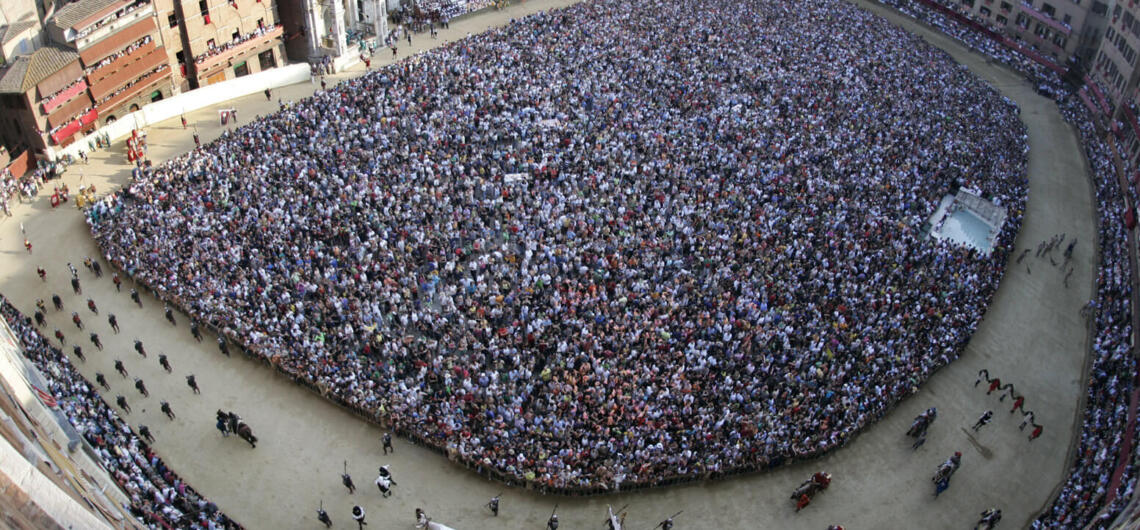
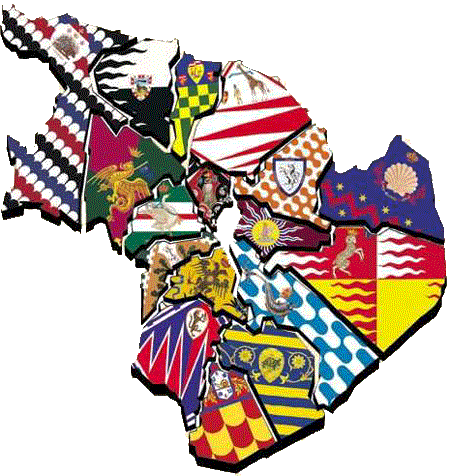




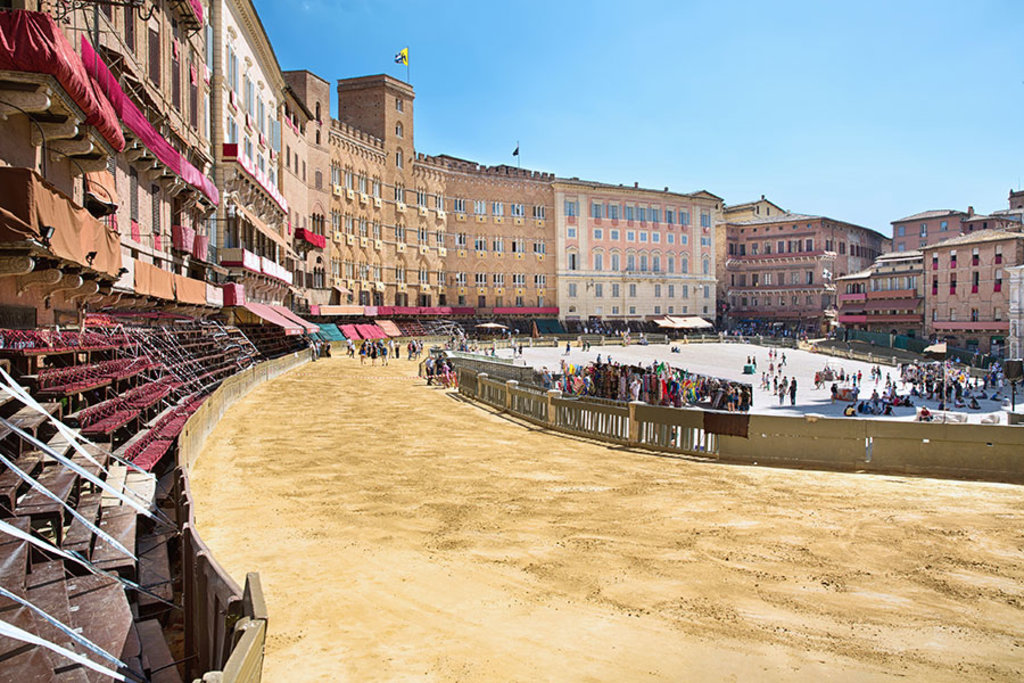


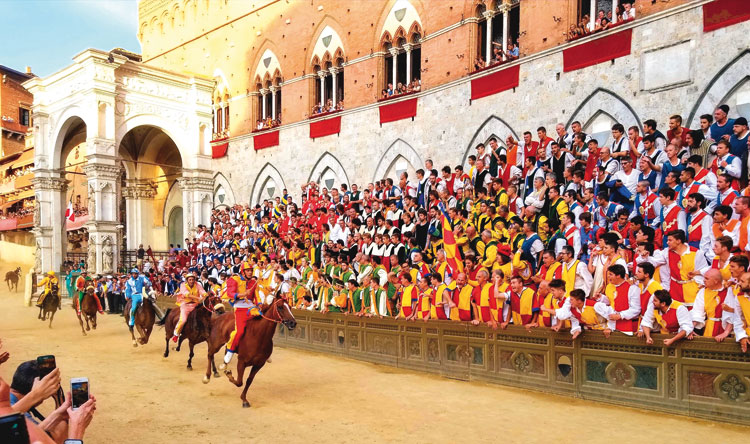
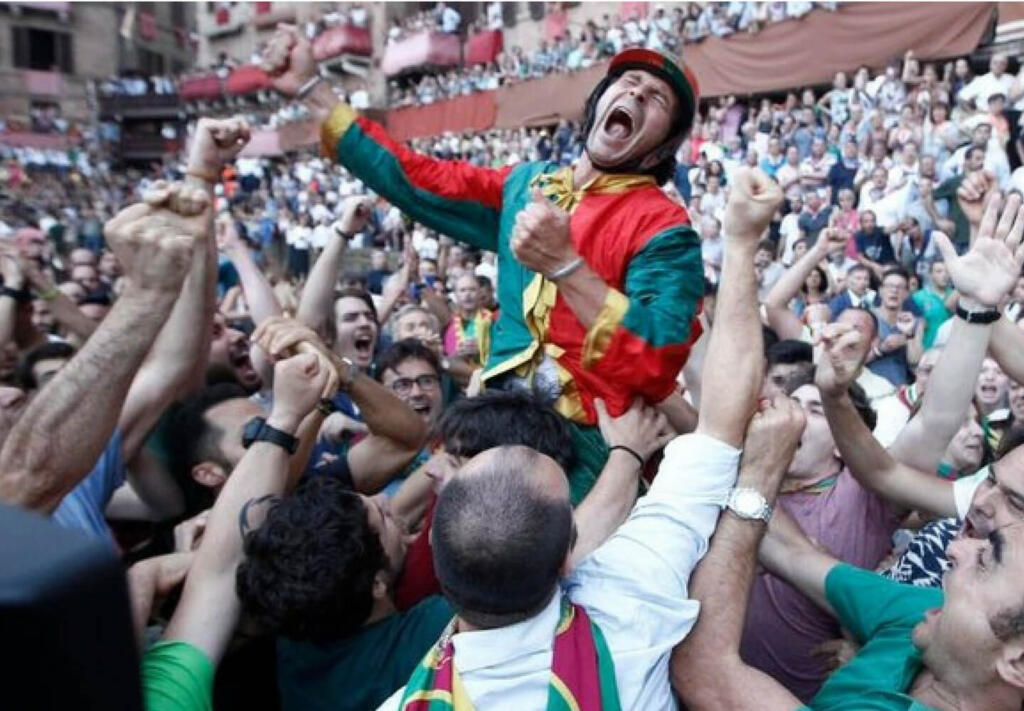
Comments